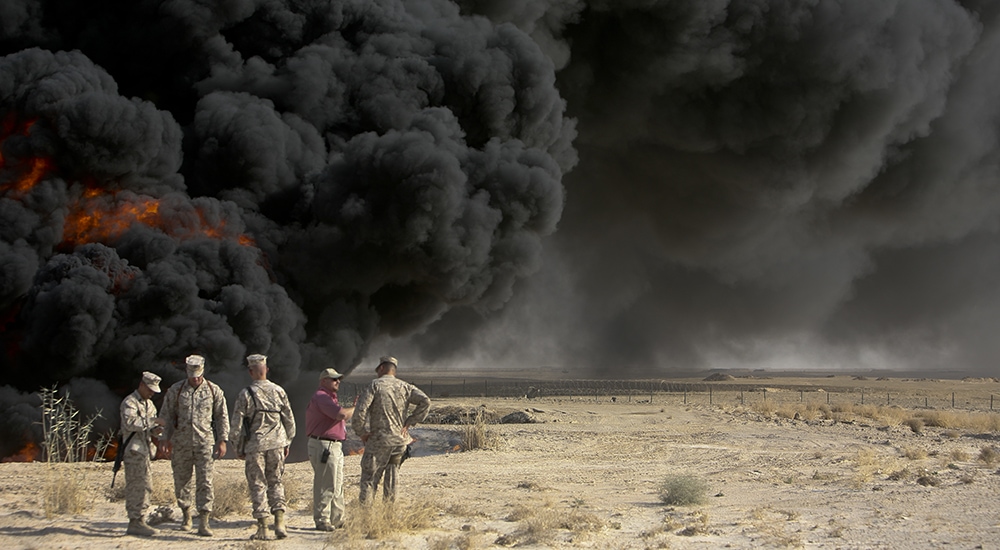View Larger Image

U.S. Marines with 1st Marine Logistics Group view burn pit at Al Taqaddum Air Base, Iraq, Sept. 22, 2008.
Image by Sgt. Jason W. Fudge, U.S. Marines
UAMS, CAVHS Studying Health Effects of Arkansas Veterans’ Exposure to Burn Pits in Middle East
| LITTLE ROCK — More than 300 Arkansas veterans will become part of a new study conducted by the University of Arkansas for Medical Sciences (UAMS) and the Central Arkansas Veterans Healthcare System (CAVHS) to determine if exposure to open pit burning and molecular-level changes are associated with chronic health conditions.
The Department of Veterans Affairs and Department of Defense (DOD) estimate that 3.5 million service members were exposed to open burn pits used for waste disposal during military deployments in Southwest Asia since 1990.
The partnership is led by UAMS’ Shuk-Mei Ho, Ph.D., and Kalpana Padala, M.D., at CAVHS and UAMS. The four-year, $2.9 million DOD-funded study will test for persistent organic pollutants in blood and heavy metals in urine, which the researchers hypothesize remain from burn pit exposure. The team will also look for modifications (methylation) in DNA that can cause long-term health problems for the veterans including epigenetic changes that can be passed to their offspring.
The study will include an assessment of each veteran’s exposure to burn pits to determine whether the duration, frequency and intensity of exposure correlates to their levels of pollutants in blood and urine, DNA modifications and chronic health issues.
“We will use cutting-edge technology to shed new light on the epigenetic signatures associated with burn pit exposure to enable discovery of biomarkers associated with the diseases we’re seeing in these veterans,” said Ho, UAMS vice chancellor for Research and Innovation and a professor in the College of Medicine Department of Pharmacology and Toxicology. “If we can establish the link between exposure and these biomarkers, they may help predict which individuals will have burn-pit exposure-related health problems down the road.”
“Our ability to identify these biomarkers is hoped to give veterans and their doctors the information needed to develop personalized prevention and treatment plans for specific medical problems,” said Padala, associate director for Clinical Research at the CAVHS Geriatric Research, Education, and Clinical Center, and associate professor in the College of Medicine Department of Geriatrics.
Ho and Padala are leading a large interdisciplinary team that will recruit study participants from about 6,800 Arkansas veterans who registered in the Veterans Affairs Airborne Hazards and Open Burn Pit (AHOBP) Registry. The study aims to enroll 220 of those registered veterans exposed to burn pits while on Middle East deployments and another 110 veterans not exposed.
Ho encourages all veterans who served in the Middle East to fill out the VA Registry Form, even those who believe they were not exposed to burn pits. The VA website states that the registry does not exclude veterans who believe they were not exposed to airborne hazards or have related health concerns. All veterans who complete the form are eligible for a free environmental health evaluation at their local VA, according to the website.
Burn pits have been used by the U.S. military to quickly eliminate solid waste. According to a National Institutes of Health-funded study published last year, over the last 20 years there were an estimated 153 burn pits in Iraq, 99 in Afghanistan, and more than 25 in Kuwait and Uzbekistan. Burn pits have been used to burn chemicals, medical and human waste, metal, munitions or unexploded ordnance, plastics, petroleum and lubricant, rubber, Styrofoam and treated wood. They were often ignited using the benzene-based jet fuel propellant as an accelerant. Thus, the smoke has considerable potential to contain pollutants toxic to individuals exposed.
Ho also noted that with Middle East operations ongoing for more than 20 years, military personnel who returned for multiple deployments increased their exposure to burn pits.
“While there is precedent for environmental exposures from the Vietnam War and the Gulf War, we have never seen war-related hazardous exposures on this scale,” Ho said, adding that similar to the experiences of first responders after the 9/11 attacks, initial skin irritations and some breathing issues may get better, but serious health conditions can emerge years later.
Ho said the research dovetails nicely with other ongoing initiatives to help veterans exposed to burn pits. Bills to expand medical coverage for this group of veterans are pending before Congress, and the VA is now requiring that its medical providers consider possible burn pit exposure when treating patients. She hopes the UAMS-CAVHS study will provide additional evidence for the VA and policymakers to support veterans’ health claims.
“I encourage all veterans who were exposed to burn pits to tell their doctors,” Ho said. “If our findings develop as we anticipate, we hope that someday they can be used for firefighters or other occupations with high levels of exposure to air pollution.”
Ho is also leading a smaller-scale pilot study on burn pit exposures that does not require veterans to have registered in the VA AHOBP Registry. She is enrolling veterans for this study to help streamline the work of the larger DOD-funded study. Veterans interested in participating in the pilot study can call (501) 398-8622 or email TRIcoordinators@uams.edu.
Preliminary data from Ho’s pilot study, supported by the UAMS Translational Research Institute, were used to help secure the DOD grant. The institute is funded by a Clinical and Translational Science Award from the National Center for Advancing Translational Sciences at the NIH, grant UL1 TR003107.
Similarly, Padala is leading a pilot study at CAVHS whose preliminary data also contributed to the successful DOD grant application. Her pilot study is analyzing VA AHOBP Registry data and not enrolling new participants. Veterans whose registry data was used in the pilot study will be invited to participate in the larger DOD study.
UAMS is the state’s only health sciences university, with colleges of Medicine, Nursing, Pharmacy, Health Professions and Public Health; a graduate school; a hospital; a main campus in Little Rock; a Northwest Arkansas regional campus in Fayetteville; a statewide network of regional campuses; and eight institutes: the Winthrop P. Rockefeller Cancer Institute, Jackson T. Stephens Spine & Neurosciences Institute, Harvey & Bernice Jones Eye Institute, Psychiatric Research Institute, Donald W. Reynolds Institute on Aging, Translational Research Institute, Institute for Digital Health & Innovation and the Institute for Community Health Innovation. UAMS includes UAMS Health, a statewide health system that encompasses all of UAMS’ clinical enterprise. UAMS is the only adult Level 1 trauma center in the state. UAMS has 3,485 students, 915 medical residents and fellows, and seven dental residents. It is the state’s largest public employer with more than 11,000 employees, including 1,200 physicians who provide care to patients at UAMS, its regional campuses, Arkansas Children’s, the VA Medical Center and Baptist Health. Visit www.uams.edu or uamshealth.com. Find us on Facebook, X (formerly Twitter), YouTube or Instagram.###

